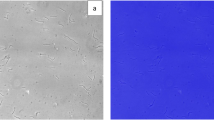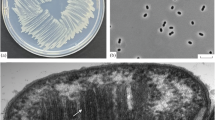Abstract
A marine mesophilic, irregular coccoid methanogen, which shows close resemblance toMethanococcus sp., was isolated from the biofilm of shiphulls docked in Los Angeles harbor. Hydrogen plus carbon dioxide or formate served as substrates for methanogenesis in a mineral salt medium. The isolate did not use acetate and methanol as sole source of carbon and energy. The organism had an optimal pH range of 6.8–7.0 and a temperature optimum of 37°C. Elevated levels of sodium chloride were required for optimum growth. Optimum levels of total sulfide and magnesium chloride for growth were 1.0mm and 10mm respectively. The isolate used ammonia as nitrogen source. The concentration of 30mm ammonium chloride supported maximum growth of the isolate.
Similar content being viewed by others
Literature Cited
Baasbecking LGM, Kaplan IR, Moore D (1960) Limits of the natural environment in terms of pH and oxidation-reduction potentials. J Geol 68:243–284
Balch WE, Wolfe RS (1976) New approach to the cultivation of methanogenic bacteria: 2-mercaptoethane sulfonic acid (HS-CoM) dependent growth ofMethanobacterium ruminantium in a pressurized atmosphere. Appl Environ Microbiol 32:781–791
Bauchop T, martucci RW (1968) Ruminant like digestion of the langur monkey. Science 161:698–700
Beijer WH (1952) Methane fermentation in the rumen cattle. Nature 170:5766
Belay N, Daniels L (1987) Production of ethane, ethylene and acetylene from halogenated hydrocarbons by methanogenic bacteria. Appl Environ Microbiol 53:1604–1610
Belay N, Daniels L (1990) Elemental metals as electron sources for biological methane formation from CO2. Antonie Van Leeuwenhoek 57:1–7
Belay N, Johnson R, Rajaogopal BS, DeMacario EC, Daniels L (1988) Methanogenic bacteria from human dental plaque. Appl Environ Microbiol 54:600–603
Belay N, Rajagopal BS, Daniels L (1990a) Effects of alkyltin compounds on hydrogen oxidizing anaerobic bacteria. Curr Microbiol 20:329–334
Belay N, Jung KY, Rajagopal BS, Kremer JD, Daniels L (1990b) Nitrate as a sole nitrogen source forMethanococcus thermolithotrophicus and its effect on growth of several methanogenic bacteria. Curr Microbiol 21:193–198
Boopathy R, Daniels L (1991) Pattern of organotin inhibition of methanogenic bacteria. Appl Environ Microbiol 57:1189–1193
Bracke JW, Cruden DL, Markovetz AJ (1979) Intestinal microbial flora of the american cockroach,Periplaneta americana L. Appl Environ Microbial 38:945–955
Chameides WL (1983) Increasing atmospheric methane. Nature 301:568
Corder RE, Hooks LA, Larkin JM, Frea JI (1983) Isolation and characterization of two new methane producing cocci:Methanogenium olentangyi, sp., nov. andMethanococcus deltae, sp., nov. Arch Microbiol 51:28–32
Daniels L, Belay N, Rajogopal BS (1986) Assimilatory reduction of sulfate and sulfite by methanogenic bacteria. Appl Environ Microbiol 51:703–709
Daniels L, Belay N, Rajagopal BS, Weimer PJ (1987) Bacterial methanogenesis and growth from CO2 with elemental iron as the sole source of electrons. Science 237:509–511
Donelen MJ (1974) Digestion in some species of scarabaeid larvae—preliminary conclusions. Australian Conference on the ecology of grassland invertebrates, Armidale, NSW. Abstract pp 39–40
Ehhalt DH (1974) The atmospheric cycle of methane. Tellus 26:58–70
Ferguson TJ, Mah RA (1983) Isolation and characterization of an H2 oxidizing thermophilic methanogen. Appl Environ Microbiol 45:265–274
Gorden RW, Fliermans (1980) Methanogenesis in thermal reactor effluents. J Thermal Biol 5:169–177
Huber J, Thomm M, Konig H, Thies G, Stetter KO (1982)Methanococcus thermolithotrophicus, a novel thermophilic lithotropic methanogen. Arch Microbiol 132:47–50
Jones WJ, Whitman WB, Fields RD, Wolfe RS (1983) Growth and plating efficiency ofMethanococci on agar media. Appl Environ Microbiol 46:220–226
Kemp CW, Curtis MA, Robrish SA, Bowen WH (1983) Biogenesis of methane in primate dental plaque. FEBS Lett 155:61–64
Leigh JA, Jones WJ (1983) A new extremely thermophilic methanogen from a submarine hydrothermal vent. Annual meeting, American Society of Microbiology, Abstract 117:142
Miller TL, Wolin MJ (1983) Oxidation of hydrogen and reduction of methanol to methane is the sole energy source for a methanogen isolated from a human faeces. J Bacteriol 153:1051–1055
Miller TL, Wolin MJ, DeMacario CE, Macario AJL (1982) Isolation ofMethanobrevibacter smithii from human faeces. Appl Environ Microbiol 43:227–232
Mukhopadhyay B, Purwantini E, deMacario EC, Daniels L (1991) Characterization of aMethanosarcina strain isolated from goat feces, and that grows on H2−CO2 only after adaptation. Curr Microbiol 23:165–173
Nottingham PM, Hungate RE (1968) Isolation of methanogenic bacteria from faeces of man. J Bacteriol 96:2178–2179
Oremland RS (1979) Methanogenic activity in plankton samples and fish intestines: a mechanism for in situ methanogenesis in oceanic surface waters. Limnol Oceanogr 24:1136–1141
Paterek R, Smith PH (1983) Isolation of a halophilic methanogenic bacterium from the sediments of Great Salt lake and a San Francisco Bay saltern. Annual meeting, American Society of Microbiology, Abstract 12:140
Paynter MJB, Hungate RE (1968) Characterization ofMethanobacterium mobilis sp. nov., isolated from the bovine rumen. J Bacteriol 95:1943–1951
Rajagopal BS, LeGall J (1989) Utilization of cathodic hydrogen by hydrogen oxidizing bacteria. Appl Microbiol Biotechnol 31:406–412
Rajagopal BS, Belay N, Daniels L (1988) Isolation and characterization of methanogenic bacteria from rice paddies. FEMS Microbiol Ecol 53:153–158
Rasmussen RA, Khalil MAK (1983) Global production of methane. Nature 301:700–702
Rivard CJ, Smith PH (1982) Isolation and characterization of a thermophilic, marine, methanogenic bacterium,Methanogenium thermophilicum sp. nov. Int J Syst Bacteriol 32:430–436
Smith PH, Hungate RE (1958) Isolation and characterization ofMethanobacterium ruminantium n. sp. J Bacteriol 75:713–718
Von Wolzogen Kuhr CAH, Van der, Vlught LS (1934) The graphitization of cast iron as an electrochemical process in anaerobic soil. Water 18:147–165
Ward DM (1978) Thermophilic methanogenesis in a hot spring algal-bacterial mat. Appl Environ Microbiol 35:1019–1026
Ward DM, Olsen GJ (1980) Terminal processes in the anaerobic degradation of an algal-bacterial mat in a high sulfate hot spring. Appl Environ Microbiol 40:67–74
William RT, Crawford RL (1983) Isolation of an acid tolerant methanogen from an acid peat land. Annual meeting, American Society of Microbiology Abstract 14:140
Yu IK, Hungate RE (1983) Isolation and characterization of an obligately halophilic, methanogenic bacterium. Annual meeting, American Society of Microbiology, Abstract 11:139
Zeikus JG, Ben-Bassat AD, Hegge PW (1980) Microbiology of methanogenesis in thermal volcanic environments. J Bacteriol 143:432–440
Zinder S, Cardwell S, Anguish T (1983) Ecology of methanogens in a thermophilic anaerobic digester. Annual meeting, American Society of Microbiology, Abstract 143:146
Author information
Authors and Affiliations
Rights and permissions
About this article
Cite this article
Boopathy, R., Daniels, L. Isolation and characterization of a marine methanogenic bacterium from the biofilm of a shiphull in Los Angeles harbor. Current Microbiology 25, 157–164 (1992). https://doi.org/10.1007/BF01571024
Issue Date:
DOI: https://doi.org/10.1007/BF01571024




